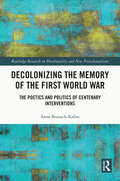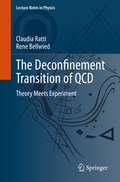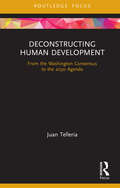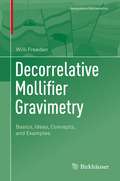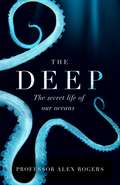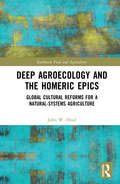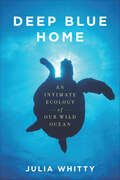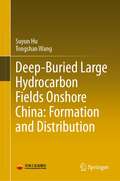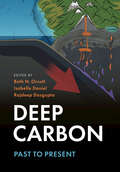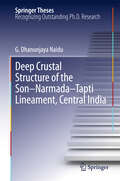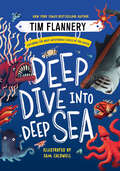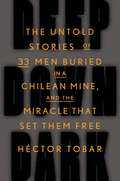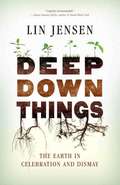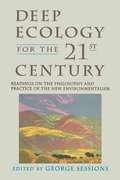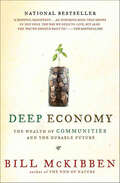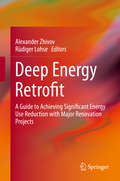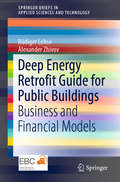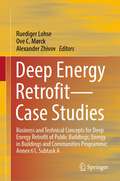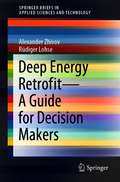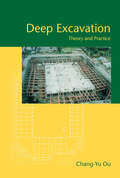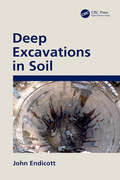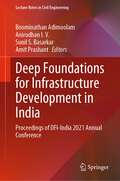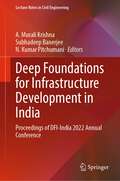- Table View
- List View
Decolonizing the Memory of the First World War: The Poetics and Politics of Centenary Interventions (Routledge Research on Decoloniality and New Postcolonialisms)
by Anna Branach-KallasDecolonizing the Memory of the First World War contributes to the imperial turn in First World War studies.This book provides an exploration of the ways in which war memory can be appropriated, neglected and disabled, but also “unlearned” and “decolonized”. The book offers an analysis of the experience of soldiers of colour in five novels published at the centenary of the First World War by David Diop, Raphaël Confiant, Fred Khumalo, Kamila Shamsie and Abdulrazak Gurnah, examining the poetics and the politics of the conflict’s commemoration. It explores continuities between WWI and earlier and later eruptions of violence, thus highlighting the long-lasting sequels of the first global conflict in the former French, British and German empires. It thereby asks important questions about the decolonization of the memory of the First World War, its tools, critical potential and limitations.The book will appeal to academics and postgraduate students working in postcolonial literatures, postcolonial and decolonial studies, First World War studies, colonial history, human and political geography, as well as readers interested in cultural memory and overlapping legacies of violence.
The Deconfinement Transition of QCD: Theory Meets Experiment (Lecture Notes in Physics #981)
by Claudia Ratti Rene BellwiedIn the last few years, numerical simulations of QCD on the lattice have reached a new level of accuracy. A wide range of thermodynamic quantities is now available in the continuum limit and for physical quark masses. This allows a comparison with measurements from heavy ion collisions for the first time. Furthermore, calculations of dynamical quantities are also becoming available. The combined effort from first principles and experiment allows to gain an unprecedented understanding of the properties of quark-gluon plasma. This concise text, geared towards postgraduate students and newcomers to the field, carefully introduces and reviews the state-of-the-art techniques and results from lattice simulations and connects them to the experimental information from RHIC and the LHC.
Deconstructing Human Development: From the Washington Consensus to the 2030 Agenda (Routledge Critical Development Studies)
by Juan TelleriaThis book provides a critical deconstruction of the human development framework promoted by the United Nations Development Programme (UNDP) since 1990. Taking the Human Development Reports of the UNDP as its starting point for reflection, this book investigates the construction of this framework as well as its political function since the end of the Cold War. The book argues that the UNDP’s discourse on development relies on essentialist philosophical, cultural, and political assumptions dating back to the 19th century and concludes that these assumptions – also present in the MDGs and SDGs – impede a full grasp of the complex and multi-layered global problems of the current world. Whilst development critiques traditionally relied on liberal, Marxist or Foucauldian theoretical frameworks and focused on epistemological or political economy issues, this book draws on the post-foundational and post-structuralist work of Ernesto Laclau and Jacques Derrida and proposes an ontological and relational reading of development discourses that both complements and further develops the insights of previous critiques. This book is key reading for advanced students and researchers of Critical Development Studies, Political Science, the UN, and Sustainable Development.
Decorrelative Mollifier Gravimetry: Basics, Ideas, Concepts, and Examples (Geosystems Mathematics)
by Willi FreedenThis monograph presents the geoscientific context arising in decorrelative gravitational exploration to determine the mass density distribution inside the Earth. First, an insight into the current state of research is given by reducing gravimetry to mathematically accessible, and thus calculable, decorrelated models. In this way, the various unresolved questions and problems of gravimetry are made available to a broad scientific audience and the exploration industry. New theoretical developments will be given, and innovative ways of modeling geologic layers and faults by mollifier regularization techniques are shown.This book is dedicated to surface as well as volume geology with potential data primarily of terrestrial origin. For deep geology, the geomathematical decorrelation methods are to be designed in such a way that depth information (e.g., in boreholes) may be canonically entered. Bridging several different geo-disciplines, this book leads in a cycle from the potential measurements made by geoengineers, to the cleansing of data by geophysicists and geoengineers, to the subsequent theory and model formation, computer-based implementation, and numerical calculation and simulations made by geomathematicians, to interpretation by geologists, and, if necessary, back. It therefore spans the spectrum from geoengineering, especially geodesy, via geophysics to geomathematics and geology, and back.Using the German Saarland area for methodological tests, important new fields of application are opened, particularly for regions with mining-related cavities or dense development in today's geo-exploration.
The Deep: The Hidden Wonders of Our Oceans and How We Can Protect Them
by Alex RogersThere's so much we don't know about what lies deep beneath the ocean's surface - and the time to find out is growing increasingly precious . . .Professor Alex Rogers is one of the world's leading experts in marine biology and oceanology, and has spent his life studying the deep ocean - and in particular the impact of human activity on the ecosystems of the oceans. In this timely, galvanising and fascinating book - replete with stunning photography of strange and beautiful creatures - Professor Rogers offers a fundamentally optimistic view of humanity's relationship with the oceans - and also a very personal account of his own interaction with the seas.
The Deep: The Hidden Wonders of Our Oceans and How We Can Protect Them
by Alex Rogers'[An] authoritative, hands-on study' NatureFrom one of the world's pre-eminent marine biologists comes a dazzling account of the wonders that lie beneath the ocean's surface, and an empowering vision of how we can protect themFewer people have been to the deepest part of the ocean than have been to the moon. Even now, the vast majority of this wilderness - which covers over 70% of the planet and forms its largest ecosystem - has never been seen by human eyes, let alone explored or investigated by scientists. Yet our oceans contain perhaps 90% of all life, and the physical and biological processes within it are critical to supporting our existence on Earth.Professor Alex Rogers has spent the past 30 years studying life in the deep ocean. In this book, he takes us on an epic and utterly unforgettable voyage to an alien world, and brings us right to the edge of what is known about our oceans today. Introducing us to glittering coral gardens, submarine mountains and a range of bizarre and breathtaking sea creatures, many of which he discovered first-hand, Rogers not only illustrates the ocean's enormous and untold impact on our lives, but also shows how we are damaging it catastrophically through pollution, overfishing, and the insidious and global effects of climate change.Imbued with the author's infectious sense of wonder, and replete with stunning photography of underwater life, The Deep is a magisterial study of a world we are only just beginning to understand - and a profoundly hopeful call to arms for us to reshape our relationship with it, before it is too late.
The Deep: The Hidden Wonders of Our Oceans and How We Can Protect Them
by Alex RogersThere's so much we don't know about what lies deep beneath the ocean's surface - and the time to find out is growing increasingly precious . . .Professor Alex Rogers is one of the world's leading experts in marine biology and oceanology, and has spent his life studying the deep ocean - and in particular the impact of human activity on the ecosystems of the oceans. In this timely, galvanising and fascinating book - replete with stunning photography of strange and beautiful creatures - Professor Rogers offers a fundamentally optimistic view of humanity's relationship with the oceans - and also a very personal account of his own interaction with the seas.(P)2019 Headline Publishing Group Ltd
Deep Agroecology and the Homeric Epics: Global Cultural Reforms for a Natural-Systems Agriculture (Earthscan Food and Agriculture)
by John W. HeadDrawing on the Homeric epics, this multidisciplinary work reveals the cultural transformations which need to take place in order to transition from today’s modern extractive agricultural system to a sustainable natural‐systems agriculture. In order to provide an imaginative foundation on which to build such a cultural transformation, the author draws on the oldest and most pervasive pair of literary works in the Western canon: the Iliad and the Odyssey. He uses themes from those foundational literary works to critique the concept of state sovereignty and to explain how innovative federalism structures around the world already show momentum building toward changes in global environmental governance. The book proposes a dramatic expansion on those innovations, to create eco‐states responsible for agroecological management. Drawing from many years of experience in international institutions, the author proposes a system of coordination by which an international agroecology‐focused organization would simultaneously (i) avoid the shortcomings of the world’s current family of powerful global institutions and (ii) help create and implement a reformed system of local landscape‐based agriculture wholly consistent with ecological principles. Acknowledging the difficulty of achieving reforms such as these, the author suggests that a new cultural‐conceptual narrative can be constructed drawing on values set forth 2,700 years ago in the Homeric epics. He explains how these values can be reimagined to drive forward our efforts in addressing today’s the climate and agricultural crises in ways that reflect, not reject, the natural processes and relationships that make the Earth a living planet. This book will be of great interest to students, academics and policymakers addressing issues of agrarian values, environmental and agricultural law, environmental restoration, agroecology, and global institutional reform.
Deep Blue Home: An Intimate Ecology of Our Wild Ocean
by Julia Whitty“A lovely, soft-spoken book about the ‘joy, inspiration, wonder, laughter, ideas’ that come from relating to Earth’s ‘nonhuman world.’”—Kirkus Review“Here is a writer of power and persuasion; one worthy of the Rachel Carson mantle. Whitty allows us to peer into the ecological web of the mysterious World Ocean, sharing her passion for the continuation of the ocean's life-essential fabric.”—Linda Lear, author of Rachel Carson: Witness for Nature “Rhythmic, poetic, transporting, and illuminating, this is the sacred memoir of a woman among islands of miracles, yearning with all her heart to be right where she is.”—Carl Safina, author of Song for the Blue Ocean, The View From Lazy Point“An illuminating exploration of the swirling currents connecting oceans, science, people, and history, bearing the reader on a unique voyage of discovery above and below the waves.”—Daniel Bennett, President of The Explorers Club —
Deep-Buried Large Hydrocarbon Fields Onshore China: Formation and Distribution
by Suyun Hu Tongshan WangThis book analyzes the formation and evolution of the giant hydrocarbon reservoirs based on major basins onshore China. It discusses exploration and research advantages of major basins in China, such as Sichuan, Tarim, and Ordos Basins and also systematically analyzes and summarizes the formation conditions, distribution rules, and main controlling factors of deep oil and gas fields. On this basis, it forecasts the exploration prospect of China's onshore deep oil and gas, providing theoretical guidance and technical support for deep oil and gas exploration breakthrough and large-scale reserves growth. This book focuses on the analysis and discussion of hydrocarbon generation mechanism of deep-paleo source rocks, discusses the accumulation rules of cross-structural reservoir formation and oil-gas enrichment in ancient strata, the combination of gypsum-salt rocks and carbonate rocks, the potential of oil and gas accumulation under salt, the main controlling factors and distribution rules of deep oil and gas fields, and preliminarily grasps the geological understanding of the formation and distribution of deep-large oil and gas fields, namely ①abundant hydrocarbon supplied by two types of source kitchens, ②three large-scale lithologic reservoir rocks, ③hydrocarbon accumulation controlled by three paleoes (paleouplift, paleoplatform margin, and paleofaults), and ④reservoir formation across major tectonic periods. The book serves as a guidance for both researchers and students majoring in petroleum geology and other related fields.
Deep Carbon: Past to Present
by Beth N. Orcutt Isabelle Daniel Rajdeep DasguptaCarbon is one of the most important elements of our planet, and ninety percent of it resides inside Earth's interior. This book summarizes ten years of research by scientists involved in the Deep Carbon Observatory, a global community of 1200 scientists. It is a comprehensive guide to carbon inside Earth, including its quantities, movements, forms, origins, changes over time, and impact on planetary processes. Leading experts from a variety of fields, including geoscience, biology, chemistry, and physics, provide exciting new insights into the interconnected nature of the global carbon cycle, and explain why it matters to the past, present, and future of our planet. With end-of-chapter problems, illustrative infographics, full-color images, and access to online models and datasets, it is a valuable reference for graduate students, researchers, and professional scientists interested in carbon cycling and Earth system science. This title is also available as Open Access on Cambridge Core.
Deep Crustal Structure of the Son-Narmada-Tapti Lineament, Central India
by G. Dhanunjaya NaiduWith a length of about 1200 km, the Son-Narmada-Tapti Lineament (NSL) is one of the most prominent geomorphic features in the Indian subcontinent. Anomalous conductive bodies are delineated at mid-lower crustal depths below major earthquake epicentral zones. The region has been interpreted as the collision zone of the Indian Plate with the Eurasian Plate. The NSL zone is therefore also known to be the second most important tectonic feature in the Indian geology, after the Himalayas. The present thesis describes significant new insight into the seismotectonics of this Central India tectonic zone, based on thorough magnetotelluric studies. The main objectives of the present study are: (i) to delineate subtrappean sediments across the NSL region along four different traverses, (ii) to understand the characterization of geo-electrical structure of the crust and examine the nature of geo-electrical signatures of the known faults, (iii) to integrate the results with other geophysical data such as seismicity, gravity and heat flow, in order to understand the tectonic scenario of the region. Deep electromagnetic (magnetotelluric) analyses were integrated in this study with gravity, seismic and heat flow studies and distinct, delineated deep crustal features. The resulting high conductivity is justified with the presence of fluids at mid-lower crustal depths. The migration of these fluids from mantle to mid-lower crustal depths through pre-existing brittle fracture/fault zones were obviously caused by the plume related to the Deccan volcanism. Migration of the fluids generated a higher fluid pressure along the faults and resulted in earthquakes. Based on the geo-electric sections derived along the four traverses of the Narmada-Son Lineament Zone, the present study gives important clues on the subduction/collision history in this important tectonic zone.
Deep Dive into Deep Sea: Exploring The Most Mysterious Levels Of The Ocean
by Tim FlanneryInternationally renowned author and scientist Tim Flannery explores the most remote and mysterious levels of Earth’s oceans. Who is the giant squid’s mortal enemy? Can you see ghosts in the deep sea? What in the world is a headless chicken monster? Tim Flannery has the answers. In this informed and accessible book, he takes readers on a journey into the darkest depths of this unchartered realm to learn about the incredible creatures living there. Divided into sections that focus on the various depths of the ocean, readers can navigate their way through the sea while being guided by anecdotes from Tim’s own personal experiences. From hairy sea devils and goblin sharks to entire ecosystems within whale carcasses, he uncovers fascinating and bizarre facts about this enchanting place and the slippery, scaly, and strange creatures that live there. Packed with vibrant illustrations and snappy engaging text, Deep Dive into Deep Sea will enthrall, enlighten, and capture the imaginations and passions of young oceanographers.
Deep Down Dark: The Untold Stories of 33 Men Buried in a Chilean Mine, and the Miracle that Set Them Free
by Héctor TobarWhen the San José mine collapsed outside of Copiapó, Chile, in August 2010, it trapped thirty-three miners beneath thousands of feet of rock for a record-breaking sixty-nine days. The entire world watched what transpired above-ground during the grueling and protracted rescue, but the saga of the miners' experiences below the Earth's surface--and the lives that led them there--has never been heard until now. For Deep Down Dark, the Pulitzer Prize-winning journalist Héctor Tobar received exclusive access to the miners and their tales. These thirty-three men came to think of the mine, a cavern inflicting constant and thundering aural torment, as a kind of coffin, and as a church where they sought redemption through prayer. Even while still buried, they all agreed that if by some miracle any of them escaped alive, they would share their story only collectively. Héctor Tobar was the person they chose to hear, and now to tell, that story. The result is a masterwork of narrative journalism--a riveting, at times shocking, emotionally textured account of a singular human event. Deep Down Dark brings to haunting, tactile life the experience of being imprisoned inside a mountain of stone, the horror of being slowly consumed by hunger, and the spiritual and mystical elements that surrounded working in such a dangerous place. In its stirring final chapters, it captures the profound way in which the lives of everyone involved in the disaster were forever changed.
Deep Down Things
by Lin JensenBeloved and critically acclaimed author Lin Jensen returns with this bounteous volume exploring what the poet Gerard Manley Hopkins calls "deep down things." Richly informed by deep ecology, Lin's writing explores our intimate connection to the land, to the specificities of place, and to the living earth itself-all as Lin uncovers our own deepest nature, the true heart of what it means to be human. There is much in what's happening in our environment now that can and perhaps should be cause for dismay - and Deep Down Things looks squarely at all of this and nonetheless gives us ample cause for celebration.
Deep Ecology for the 21st Century
by George SessionsEvery day, in newspapers and on television, we read and hear about the ongoing destruction of the environment: the greenhouse effect, ozone layer depletion, deforestation, and air and water pollution. Deep Ecology offers a solution to the environmental crisis through a radical shift in human consciousness, a fundamental change in the way people relate with the environment. Instead of thinking of nature as a resource to be used for human needs, Deep Ecology argues that the true value of nature is intrinsic and independent of its utility. Emerging in the 1980s as an influential philosophical, social, and political movement, Deep Ecology has shaped the environmental debate among leading activists and policymakers-from former Vice-President Al Gore to Dave Forman, cofounder of Earth First! Deep Ecology for the Twenty-First Century contains thirty-nine articles by the leading writers and thinkers in the filed, offering a comprehensive array of perspectives on this new approach to environmentalism, exploring: The basic philosophy of Deep Ecology. Its roots in the writings of Henry David Thoreau, John Muir and Rachel Carson. The relationship of Deep Ecology to social ecology, ecofeminism, the Greens, and New Age futurism. How Deep Ecology as a way of life is exemplified by two important environmentalists: poet Gary Snyder and Norwegian philosopher Arne Naess. The philosophical dimensions of this environmental movement by its leading theorist. The politics of ecological sustainability and the social and political implications of Deep Ecology for the next century.
Deep Economy: The Wealth of Communities and the Durable Future
by Bill McKibbenThe bestselling author of The End of Nature issues an impassioned call to arms for an economy that creates community and ennobles our livesIn this powerful and provocative manifesto, Bill McKibben offers the biggest challenge in a generation to the prevailing view of our economy. For the first time in human history, he observes, "more" is no longer synonymous with "better"—indeed, for many of us, they have become almost opposites. McKibben puts forward a new way to think about the things we buy, the food we eat, the energy we use, and the money that pays for it all. Our purchases, he says, need not be at odds with the things we truly value.McKibben's animating idea is that we need to move beyond "growth" as the paramount economic ideal and pursue prosperity in a more local direction, with cities, suburbs, and regions producing more of their own food, generating more of their own energy, and even creating more of their own culture and entertainment. He shows this concept blossoming around the world with striking results, from the burgeoning economies of India and China to the more mature societies of Europe and New England. For those who worry about environmental threats, he offers a route out of the worst of those problems; for those who wonder if there isn't something more to life than buying, he provides the insight to think about one's life as an individual and as a member of a larger community.McKibben offers a realistic, if challenging, scenario for a hopeful future. Deep Economy makes the compelling case that the more we nurture the essential humanity of our economy, the more we will recapture our own.
Deep Energy Retrofit: A Guide to Achieving Significant Energy Use Reduction with Major Renovation Projects (Springerbriefs In Applied Sciences And Technology Ser.)
by Alexander Zhivov Rüdiger LohseThis book provides detailed information on how to set up Deep Energy Retrofits (DERs) in public buildings, and shares in-depth insights into the current status of the major technologies, strategies and best practice examples of how to cost-effectively combine them. Case studies from the U.S.A. and Europe show that that Deep Energy Retrofit can be achieved with a limited core technologies bundle readily available on the market. Characteristics of some of these core technology measures depend on the technologies available on an individual nation’s market, on the minimum requirements of national standards, and on economics (as determined by a life cycle cost analysis). Also, requirements to building envelope-related technologies (e.g., insulation levels, windows, vapor and water barriers, and requirements for building airtightness) depend on specific climate conditions. This Guide provides best practice examples of how to apply these technologies in different construction situations.High levels of energy use reduction using core technology bundles along with improvements in indoor climate and thermal comfort can be only achieved when a Deep Energy Retrofit adopts a quality assurance process. In addition to design, construction, commissioning, and post-occupancy phases of the quality assurance process, the Guide emphasizes the importance of clearly and concisely formulating and documenting the Owner’s goals, expectations, and requirements for the renovated building during development of the statement of work. Another important component of the quality assurance process is a procurement phase, during which bidders’ qualifications, their understanding of the scope of work and its requirements, and their previous experience are analyzed.The building sector holds the potential for tremendous improvements in terms of energy efficiency and reducing carbon emissions, and energy retrofits to the existing building stock represent a significant opportunity in the transition to a low-carbon future. Moreover, investing in highly efficient building materials and systems can replace long-term energy imports, contribute to cost cutting, and create a wealth of new jobs. Yet, while the technologies needed in order to improve energy efficiency are readily available, significant progress has not yet been made, and “best practices” for implementing building technologies and renewable energy sources are still relegated to small “niche” applications.Offering essential information on Deep Energy Retrofits, the book offers a valuable asset for architects, public authorities, project developers, and engineers alike.
Deep Energy Retrofit Guide for Public Buildings: Business and Financial Models (SpringerBriefs in Applied Sciences and Technology)
by Rüdiger Lohse Alexander ZhivovThis book provides detailed information on how to set up Deep Energy Retrofits (DERs) in public buildings, and shares in-depth insights into the current status of the major technologies, strategies and practical best practice examples of how to cost-effectively combine them. Case studies from Europe are analyzed with respect to energy use before and after renovation, reasons for undertaking the renovation, co-benefits achieved, resulting cost-effectiveness, and the business models employed. The building sector holds the potential for tremendous improvements in terms of energy efficiency and reducing carbon emissions, and energy retrofits to the existing building stock represent a significant opportunity in the transition to a low-carbon future. Moreover, investing in highly efficient building materials and systems can replace long-term energy imports, contribute to cost cutting, and create a wealth of new jobs. Yet, while the technologies needed in order to improve energy efficiency are readily available, significant progress has not yet been made, and “best practices” for implementing building technologies and renewable energy sources are still relegated to small “niche” applications. Offering essential information on Deep Energy Retrofits, the book offers a valuable asset for architects, public authorities, project developers, and engineers alike.
Deep Energy Retrofit—Case Studies: Business and Technical Concepts for Deep Energy Retrofit of Public Buildings; Energy in Buildings and Communities Programme; Annex 61, Subtask A
by Ruediger Lohse Ove C. Mørck Alexander ZhivovThis book describes results of research conducted with the goal of providing a framework, selected tools, and guidelines to significantly reduce energy use (by more than 50%) in government and public buildings. The scope of the book is limited to public buildings that were constructed before the 1980s with low internal loads (e.g., office buildings, dormitories, barracks, public housing, and educational buildings) and that were undergoing major renovation. The book contains description and analysis of 26 well-documented case studies from Europe (Austria, Denmark, Estonia, Germany, Ireland, Latvia, Montenegro, The Netherlands, and the UK) and the USA. After these data were collected, the case studies were analyzed with respect to energy use (before and after renovation), reasons for undertaking the renovation, co-benefits achieved, resulting cost-effectiveness, and the business models followed. Finally, “lessons learned” were compiled and compared.Deep Energy Retrofit (DER) is a major building renovation project in which site energy use intensity (including plug loads) has been reduced by at least 50% from the pre-renovation baseline with a corresponding improvement in indoor environmental quality and comfort. Lessons learned from the case studies and experiences of the team clearly indicate that DER can be achieved with the application of “bundles” of a limited number of core technologies readily available on the market. Specific characteristics of some of these core technology bundles generally depend on the technologies available on an individual nation’s market, on the minimum requirements of national standards, and on economics (as determined by a life cycle cost [LCC] analysis).
Deep Energy Retrofit—A Guide for Decision Makers (SpringerBriefs in Applied Sciences and Technology)
by Alexander Zhivov Rüdiger LohseMany governments worldwide are setting more stringent targets for reductions in energy use in government/public buildings. Buildings constructed more than 10 years ago account for a major share of energy used by the building stock. However, the funding and “know-how” (applied knowledge) available for owner-directed energy retrofit projects has not kept pace with new requirements. With typical retrofit projects, reduction of energy use varies between 10 and 20%, while actual executed renovation projects show that energy use reduction can exceed 50%, and can cost-effectively achieve the Passive House standard or even approach net zero-energy status (EBC Annex 61 2017a, Hermelink and Müller 2010; NBI 2014; RICS 2013; Shonder and Nasseri 2015; Miller and Higgins 2015; Emmerich et al. 2011).Building energy efficiency (EE) ranks first in approaches with resource efficiency potential with a total resource benefit of approximately $700 billion until 2030. EE is by far the cheapest way to cut CO2 emissions (McKinsey 2011, IPCC 2007). However, according to an IEA study (IEA 2014a), more than 80% of savings potential in building sector remains untapped. Thus, the share of deployed EE in the building sector is lower than in the Industry, Transport, and Energy generation sectors. Estimates for the deep renovation potentials show: €600-900bn investment potential, €1000-1300bn savings potential, 70% energy-saving potential, and 90% CO2 reduction potential.
Deep Excavation: Theory and Practice
by Chang-Yu OuWith continued economic development and increasing urbanization, excavations go deeper and become larger in scale, and are sometimes even carried out in difficult soils. These conditions require advanced analysis and design methods and construction technologies. Most books on general foundation engineering introduce the basic analysis and design of excavation, but do not delve into practical considerations. This book examines both theory and practice, from basic to advanced, and discusses the major methods currently in practice around the world. Each chapter also includes problems and their solutions to develop a practical, real-world understanding.
Deep Excavations in Soil
by John EndicottThe book describes the theory and current practices for design of earth lateral support for deep excavations in soil. It addresses basic principles of soil mechanics and explains how these principles are embodied in design methods including hand calculations. It then introduces the use of numerical methods including the fundamental “beam on springs” models, and then more sophisticated computer programmes which can model soil as a continuum in two or three dimensions. Constitutive relationships are introduced that are in use for representing the behaviour of soil including a strain hardening model, and a Cam Clay model including groundwater flow and coupled consolidation. These methods are illustrated by reference to practical applications and case histories from the author’s direct experience, and some of the pitfalls that can occur are discussed. Theory and design are strongly tied to construction practice, with emphasis on monitoring the retaining structures and movement of surrounding ground and structures, in the context of safety and the Observational Method. Examples are presented for conventional “Bottom-up” and “Top-down” sequences, along with hybrid sequences giving tips on how to optimise the design and effect economies of cost and time for construction. It is written for practising geotechnical, civil and structural engineers, and especially for senior and MSc students.
Deep Foundations for Infrastructure Development in India: Proceedings of DFI-India 2021 Annual Conference (Lecture Notes in Civil Engineering #315)
by Boominathan Adimoolam Anirudhan I. V. Sunil S. Basarkar Amit PrashantThis book contains select proceedings of the 10th annual conference of Deep Foundations Institute of India, DFI India, 2021. It presents papers on 1) Geotechnical Investigation, Testing, Instrumentation, Monitoring, and Quality Management, 2) Ground Improvement Techniques, 3) Piling and Deep Foundation Techniques, 4) Earth Retention and Deep Excavation Support, 5) Research, Experimental and Numerical Methods in Deep Foundations and Deep Excavation Technologies, and 6) Safe and Efficient Geo-Construction. This book has seventeen articles, each with a specific field application value. The probabilistic approach in evaluating the field data, namely SPT N and pressure meter modulus for arriving at the geotechnical design parameters, multiphase site investigation program for complex underground construction activity, the safety of working platforms in foundation construction projects, usage of liner piles to support the reaction platform for static loading tests for piles, choice of foundation system for three bridges, emphasis on the importance of selecting an appropriate foundation system for the safe and timely completion of the project, challenges in deep excavations, constructions in confined spaces, groundwater level variations, and their influence on tunneling have been discussed. The usefulness of numerical analysis in the design of deep excavations and ground improvement projects is highlighted. The articles covered in this book are of immense value to professionals and academicians for improving their work practice.
Deep Foundations for Infrastructure Development in India: Proceedings of DFI-India 2022 Annual Conference (Lecture Notes in Civil Engineering #373)
by A. Murali Krishna Subhadeep Banerjee N. Kumar PitchumaniThis book comprises select proceedings of the 11th annual conference of Deep Foundations Institute of India, DFI India 2022, held during 15–17 September 2022 in Tirupati. The conference showcased advancements in deep foundation technologies through articles on research and case histories. The book presents papers on deep foundation and deep excavation technologies for metro and high-speed rail; innovative techniques and testing for geotechnical investigations; monitoring, performance, and the QA-QC of deep foundations; challenges to working and the impact of existing codes with respect to technical innovations in deep foundations; ground improvement techniques for mass stabilization; geotechnics for marine, near-shore, and coastal constructions; research, experimental and numerical methods in deep foundations and deep excavation technologies; mono-piles and other advanced deep foundation systems; deep foundations in coralline and carbonate rocks and other unique and interesting papers related to deep foundation themes.
